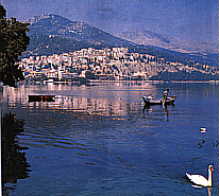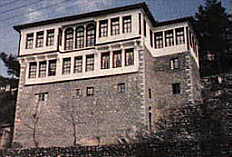|
|
History

You can
lodge in one of the city hotels, which offer you a pleasant
stay and also unique hospitality. After a short rest, you can
walk through the narrow picturesque streets of the city. An
acquaintance with the history which goes back into the
centuries: Rich prehistoric and archeological findings
(Limneos settlement, Dispilio, Armenohore). But, let's start
from the very beginning.
Kastoria
acquired its name front the Macedonian hero of' Mythology,
Kastor, son of Zeus. The geographical area of Kastoria is
identified as the small ancient Macedonian state of Orestiada,
whose inhabitants were called Orestes and the capital Argos
Orestikon. From that point, according to history, the
Macedonian kings started to merge the rest small states which
formed the big Macedonian state whose capital was Eges
(Vergina) and later, Pella. During the Roman times, the city
of Kastoria had the fate of the rest of Macedonia. Fame and
glamour followed in the Byzantine era. In many places of the
city one can clearly see traces of the fortification dated
from the days of loustinianus protecting the city from
barbarian invasions.
Ruins of the
Byzantine Wall make us conclude that the lake was at those
days, as high as where the modern city is now built. Acropolis
was situated on the highest place where now there is the guest
- room and the reservoir of the city. It is obvious that
during the Bvzantine period many of the inhabitants lived
outside the Wall, at the hill where many churches are saved up
to now.

In the past Byzantine period, Kastoria has raised many Benefactors and
Teachers of the Nation, while it took part in the 1821
Revolution with a corps of its own people. During the 19th
century, Kastoria participated in the Revolution against the
Turkish and played an important role during the Macedonian
struggle against both Turks and Bulgarians, In 1912, Kastoria
became a part of Greece. Today, Kastoria is a city of 35.000
inhabitants, a city bursting of life and progress, while it
has a strong connection with its history and mythical past.
It is a
challenge to the visitors seeing the 40 or more Byzantine
churches (Temples) and the numerous - around 250 - Macedonian
neo-classical houses. One can see churches appearing at every
crossroad and yard. Inscriptions give us the information that
the churches were built by Kastorians who had lived most of
their lives abroad, or lords in exile, or people of a whole
neighborhood and finally from members of a Trade union. Only
the old ones are clearly shown, the others - built much later
- are placed in the backyards where it is difficult to be
seen. On Omonia Square, the visitors make the first
acquaintance of Kastoria's Byzantine Art. A little further we
can visit Saint Nikolaos Kasnitzi, Taxiarches and Panagia
Koumpelidiki. From the Omonia Square we advise you to visit
Agios Minas Square from Valala street. There, you could find
the Agios Stefanos and Agii Anargiri churches.
|